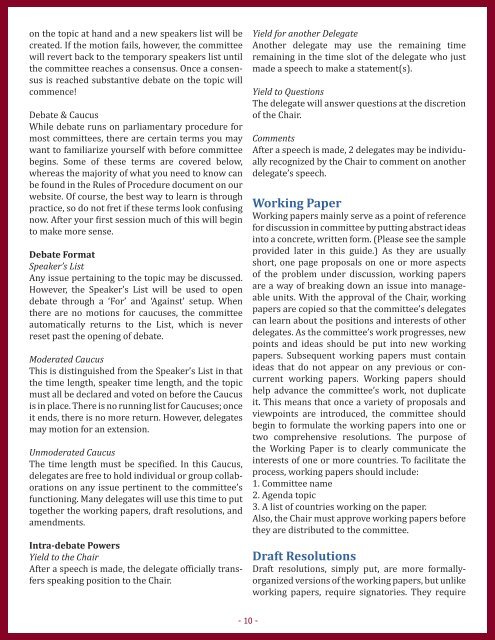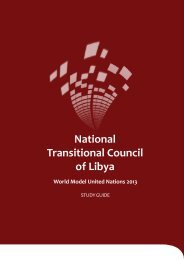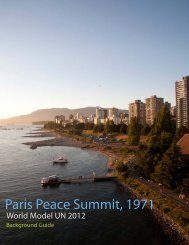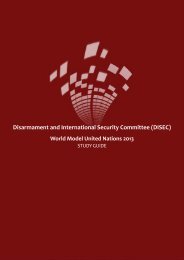here - World Model United Nations
here - World Model United Nations
here - World Model United Nations
Create successful ePaper yourself
Turn your PDF publications into a flip-book with our unique Google optimized e-Paper software.
on the topic at hand and a new speakers list will be<br />
created. If the motion fails, however, the committee<br />
will revert back to the temporary speakers list until<br />
the committee reaches a consensus. Once a consensus<br />
is reached substantive debate on the topic will<br />
commence!<br />
Debate & Caucus<br />
While debate runs on parliamentary procedure for<br />
most committees, t<strong>here</strong> are certain terms you may<br />
want to familiarize yourself with before committee<br />
begins. Some of these terms are covered below,<br />
w<strong>here</strong>as the majority of what you need to know can<br />
be found in the Rules of Procedure document on our<br />
website. Of course, the best way to learn is through<br />
practice, so do not fret if these terms look confusing<br />
now. After your first session much of this will begin<br />
to make more sense.<br />
Debate Format<br />
Speaker’s List<br />
Any issue pertaining to the topic may be discussed.<br />
However, the Speaker’s List will be used to open<br />
debate through a ‘For’ and ‘Against’ setup. When<br />
t<strong>here</strong> are no motions for caucuses, the committee<br />
automatically returns to the List, which is never<br />
reset past the opening of debate.<br />
Moderated Caucus<br />
This is distinguished from the Speaker’s List in that<br />
the time length, speaker time length, and the topic<br />
must all be declared and voted on before the Caucus<br />
is in place. T<strong>here</strong> is no running list for Caucuses; once<br />
it ends, t<strong>here</strong> is no more return. However, delegates<br />
may motion for an extension.<br />
Unmoderated Caucus<br />
The time length must be specified. In this Caucus,<br />
delegates are free to hold individual or group collaborations<br />
on any issue pertinent to the committee’s<br />
functioning. Many delegates will use this time to put<br />
together the working papers, draft resolutions, and<br />
amendments.<br />
Intra-debate Powers<br />
Yield to the Chair<br />
After a speech is made, the delegate officially transfers<br />
speaking position to the Chair.<br />
- 10 -<br />
Yield for another Delegate<br />
Another delegate may use the remaining time<br />
remaining in the time slot of the delegate who just<br />
made a speech to make a statement(s).<br />
Yield to Questions<br />
The delegate will answer questions at the discretion<br />
of the Chair.<br />
Comments<br />
After a speech is made, 2 delegates may be individually<br />
recognized by the Chair to comment on another<br />
delegate’s speech.<br />
Working Paper<br />
Working papers mainly serve as a point of reference<br />
for discussion in committee by putting abstract ideas<br />
into a concrete, written form. (Please see the sample<br />
provided later in this guide.) As they are usually<br />
short, one page proposals on one or more aspects<br />
of the problem under discussion, working papers<br />
are a way of breaking down an issue into manageable<br />
units. With the approval of the Chair, working<br />
papers are copied so that the committee’s delegates<br />
can learn about the positions and interests of other<br />
delegates. As the committee’s work progresses, new<br />
points and ideas should be put into new working<br />
papers. Subsequent working papers must contain<br />
ideas that do not appear on any previous or concurrent<br />
working papers. Working papers should<br />
help advance the committee’s work, not duplicate<br />
it. This means that once a variety of proposals and<br />
viewpoints are introduced, the committee should<br />
begin to formulate the working papers into one or<br />
two comprehensive resolutions. The purpose of<br />
the Working Paper is to clearly communicate the<br />
interests of one or more countries. To facilitate the<br />
process, working papers should include:<br />
1. Committee name<br />
2. Agenda topic<br />
3. A list of countries working on the paper.<br />
Also, the Chair must approve working papers before<br />
they are distributed to the committee.<br />
Draft Resolutions<br />
Draft resolutions, simply put, are more formallyorganized<br />
versions of the working papers, but unlike<br />
working papers, require signatories. They require
















